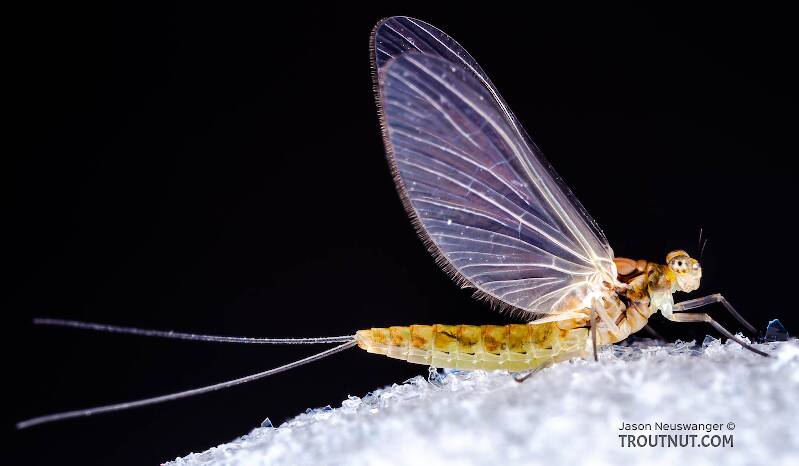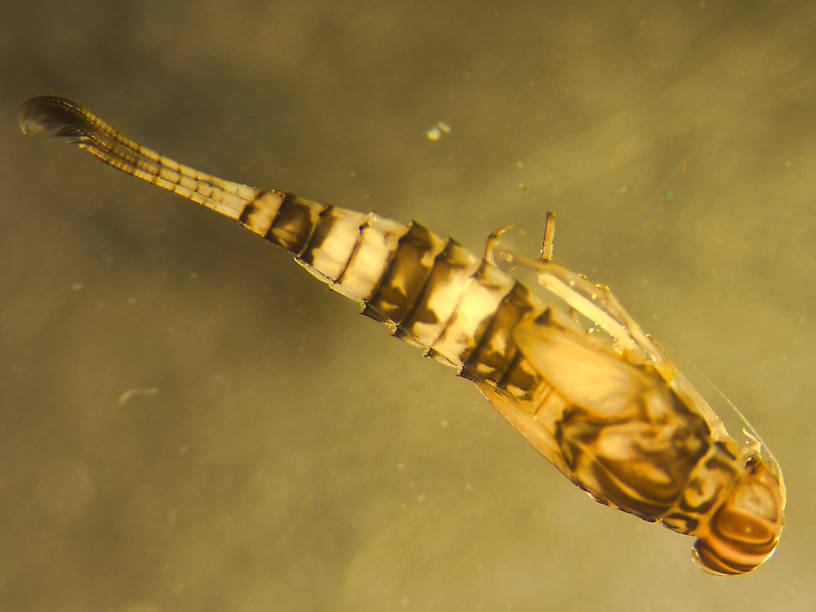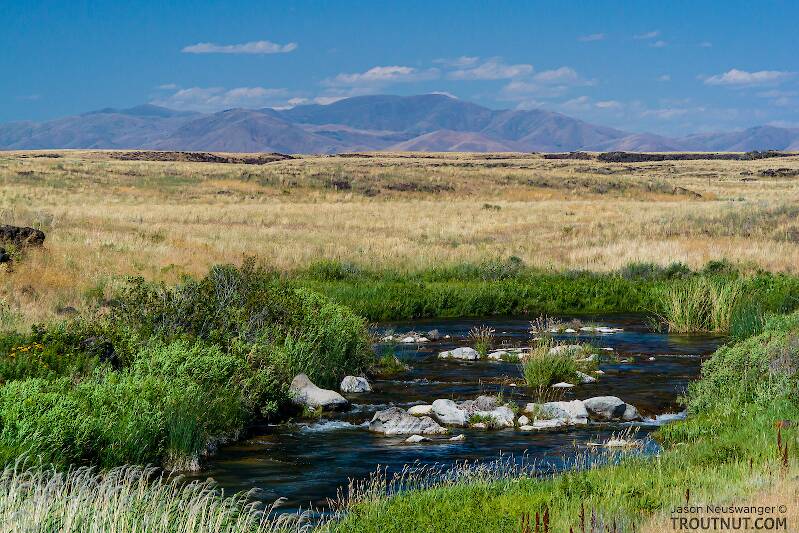
Salmonflies
Pteronarcys californica
The giant Salmonflies of the Western mountains are legendary for their proclivity to elicit consistent dry-fly action and ferocious strikes.
Featured on the forum

This specimen appears to be of the same species as this one collected in the same spot two months earlier. The identification of both is tentative. This one suffered some physical damage before being photographed, too, so the colors aren't totally natural. I was mostly photographing it to test out some new camera setting idea, which worked really well for a couple of closeups.

Troutnut is a project started in 2003 by salmonid ecologist Jason "Troutnut" Neuswanger to help anglers and
fly tyers unabashedly embrace the entomological side of the sport. Learn more about Troutnut or
support the project for an enhanced experience here.
Mayfly Genus Procloeon (Tiny Sulphur Duns)
This genus is not well-known to fly fishers because most of its species were, until very recently, classified as either Centroptilum or Cloeon.
These mayflies may be abundant enough to cause fishable hatches in spite of their tiny size.
It's difficult to discern from previous angling literature exactly which statements now apply to Procloeon, because its species come from other little-known genera and the accounts for them conflict. They were mentioned in combination with other genera, adding to the confusion. So the information below is highly tentative and, where accounts seem to conflict, both have been given.
These mayflies may be abundant enough to cause fishable hatches in spite of their tiny size.
It's difficult to discern from previous angling literature exactly which statements now apply to Procloeon, because its species come from other little-known genera and the accounts for them conflict. They were mentioned in combination with other genera, adding to the confusion. So the information below is highly tentative and, where accounts seem to conflict, both have been given.
Where & when
Preferred waters: Best in alkaline streams
In 71 records from GBIF, adults of this genus have mostly been collected during July (30%), August (27%), June (27%), September (7%), and October (6%).
In 100 records from GBIF, this genus has been collected at elevations ranging from 3 to 29016 ft, with an average (median) of 1411 ft.
Genus Range
Hatching behavior
Trout may feed well on the tiny nymphs during a hatch. Caucci and Nastasi discovered and noted in Hatches II that these nymphs, despite their excellent swimming ability most of the time, become nearly immobile shortly before hatching. They slowly crawl out of the water or dead-drift float to the surface, buoyed by gases they release.According to one source, the duns crawl out onto shore to emerge.
Spinner behavior
Procloeon duns usually molt into spinners, mate, and die the very day they hatched. Dun and spinner activity may overlap.Nymph biology
Current speed: Slow
Substrate: Many, but weeds are best
Specimens of the Mayfly Genus Procloeon
1 Female Dun

This dun of a fairly large Baetidae species was one of only a couple I saw all evening.
1 Nymph

This fragile nymph is easily damaged during sampling making identification more difficult.
Start a Discussion of Procloeon
References
- Caucci, Al and Nastasi, Bob. 2004. Hatches II. The Lyons Press.
- Knopp, Malcolm and Robert Cormier. 1997. Mayflies: An Angler's Study of Trout Water Ephemeroptera . The Lyons Press.
- Schwiebert, Ernest G. 1955. Matching the Hatch. MacMillan Publishing Company.
Mayfly Genus Procloeon (Tiny Sulphur Duns)
Taxonomy
Species in Procloeon
Procloeon bellum
0
0
Procloeon caliginosum
0
0
Procloeon fragile
0
0
Procloeon inanum
0
0
Procloeon ingens
0
0
Procloeon insignificans
0
0
Procloeon intermediale
0
0
Procloeon mendax
0
0
Procloeon ozburni
0
0
Procloeon pennulatum
1
1
Procloeon quaesitum
0
0
Procloeon rivulare
0
0
Procloeon rubropictum
0
0
Procloeon rufostrigatumJenny Spinners
0
0
Procloeon simile
0
0
Procloeon simplex
0
0
Procloeon venosumTiny Sulphur Duns
0
0
Procloeon vicinum
0
0
Species in Procloeon: Procloeon bellum, Procloeon caliginosum, Procloeon fragile, Procloeon inanum, Procloeon ingens, Procloeon insignificans, Procloeon intermediale, Procloeon mendax, Procloeon ozburni, Procloeon pennulatum, Procloeon quaesitum, Procloeon rivulare, Procloeon rubropictum, Procloeon rufostrigatum, Procloeon simile, Procloeon simplex, Procloeon venosum, Procloeon vicinum
4 species (Procloeon distinctum, Procloeon nelsoni, Procloeon texanum, and Procloeon viridoculare) aren't included.

